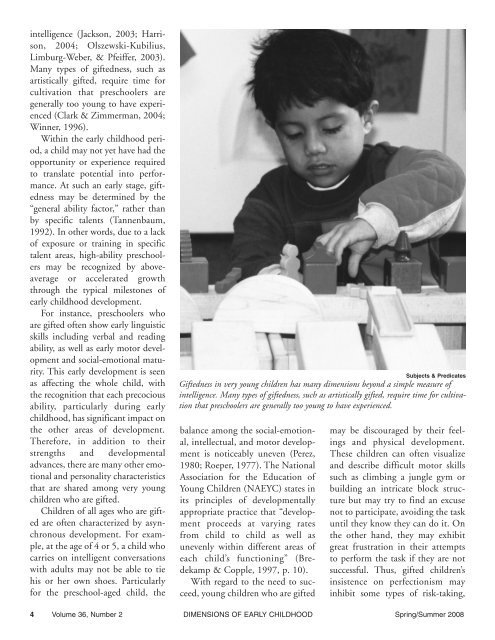Recognizing Giftedness: Defining High Ability in Young Children
Recognizing Giftedness: Defining High Ability in Young Children
Recognizing Giftedness: Defining High Ability in Young Children
Create successful ePaper yourself
Turn your PDF publications into a flip-book with our unique Google optimized e-Paper software.
<strong>in</strong>telligence (Jackson, 2003; Harrison,<br />
2004; Olszewski-Kubilius,<br />
Limburg-Weber, & Pfeiffer, 2003).<br />
Many types of giftedness, such as<br />
artistically gifted, require time for<br />
cultivation that preschoolers are<br />
generally too young to have experienced<br />
(Clark & Zimmerman, 2004;<br />
W<strong>in</strong>ner, 1996).<br />
With<strong>in</strong> the early childhood period,<br />
a child may not yet have had the<br />
opportunity or experience required<br />
to translate potential <strong>in</strong>to performance.<br />
At such an early stage, giftedness<br />
may be determ<strong>in</strong>ed by the<br />
“general ability factor,” rather than<br />
by specific talents (Tannenbaum,<br />
1992). In other words, due to a lack<br />
of exposure or tra<strong>in</strong><strong>in</strong>g <strong>in</strong> specific<br />
talent areas, high-ability preschoolers<br />
may be recognized by aboveaverage<br />
or accelerated growth<br />
through the typical milestones of<br />
early childhood development.<br />
For <strong>in</strong>stance, preschoolers who<br />
are gifted often show early l<strong>in</strong>guistic<br />
skills <strong>in</strong>clud<strong>in</strong>g verbal and read<strong>in</strong>g<br />
ability, as well as early motor development<br />
and social-emotional maturity.<br />
This early development is seen<br />
as affect<strong>in</strong>g the whole child, with<br />
the recognition that each precocious<br />
ability, particularly dur<strong>in</strong>g early<br />
childhood, has significant impact on<br />
the other areas of development.<br />
Therefore, <strong>in</strong> addition to their<br />
strengths and developmental<br />
advances, there are many other emotional<br />
and personality characteristics<br />
that are shared among very young<br />
children who are gifted.<br />
<strong>Children</strong> of all ages who are gifted<br />
are often characterized by asynchronous<br />
development. For example,<br />
at the age of 4 or 5, a child who<br />
carries on <strong>in</strong>telligent conversations<br />
with adults may not be able to tie<br />
his or her own shoes. Particularly<br />
for the preschool-aged child, the<br />
Subjects & Predicates<br />
<strong>Giftedness</strong> <strong>in</strong> very young children has many dimensions beyond a simple measure of<br />
<strong>in</strong>telligence. Many types of giftedness, such as artistically gifted, require time for cultivation<br />
that preschoolers are generally too young to have experienced.<br />
balance among the social-emotional,<br />
<strong>in</strong>tellectual, and motor development<br />
is noticeably uneven (Perez,<br />
1980; Roeper, 1977). The National<br />
Association for the Education of<br />
<strong>Young</strong> <strong>Children</strong> (NAEYC) states <strong>in</strong><br />
its pr<strong>in</strong>ciples of developmentally<br />
appropriate practice that “development<br />
proceeds at vary<strong>in</strong>g rates<br />
from child to child as well as<br />
unevenly with<strong>in</strong> different areas of<br />
each child’s function<strong>in</strong>g” (Bredekamp<br />
& Copple, 1997, p. 10).<br />
With regard to the need to succeed,<br />
young children who are gifted<br />
may be discouraged by their feel<strong>in</strong>gs<br />
and physical development.<br />
These children can often visualize<br />
and describe difficult motor skills<br />
such as climb<strong>in</strong>g a jungle gym or<br />
build<strong>in</strong>g an <strong>in</strong>tricate block structure<br />
but may try to f<strong>in</strong>d an excuse<br />
not to participate, avoid<strong>in</strong>g the task<br />
until they know they can do it. On<br />
the other hand, they may exhibit<br />
great frustration <strong>in</strong> their attempts<br />
to perform the task if they are not<br />
successful. Thus, gifted children’s<br />
<strong>in</strong>sistence on perfectionism may<br />
<strong>in</strong>hibit some types of risk-tak<strong>in</strong>g,<br />
4 Volume 36, Number 2 DIMENSIONS OF EARLY CHILDHOOD Spr<strong>in</strong>g/Summer 2008
















